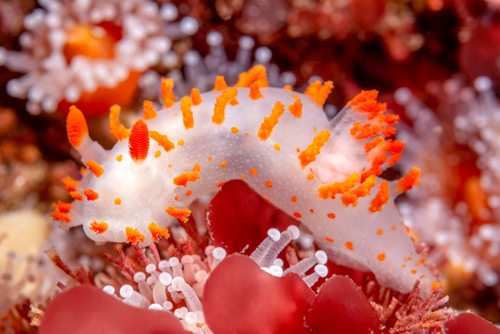Shakespeare said, “A rose by any other name would smell as sweet,” however, he had probably never heard of a fried egg jellyfish or a penis snake. Whether it’s the depths of the sea, the rivers of Brazil, or the trees of New Zealand, there are animals abound with frightening, silly, and downright unusual names. Of all the species surviving and thriving on our great planet, here are six animals with strange names.
1. Pink Fairy Armadillo (Chlamyphorus truncatus)
[embedded content]
Pink fairy armadillos are in good company with their strange name. Many types of armadillos have unusual monikers, like their distant relative, the screaming hairy armadillo. Pink fairy armadillos are solitary creatures that live in central Argentina, particularly in dry grasslands, deserts, and sandy plains. Weighing in at a quarter pound, they are the smallest living armadillos, growing up to 6 inches. Pink fairy armadillos have trouble walking on flat surfaces and use their oversized claws to burrow through the earth and bury themselves.
Read More: These Rare Adaptations Help Animals Survive in the Desert
2. Penis Snake (Atretochoana eiselti)
(Credit: Tobias von Anhalt, CC BY-SA 3.0 <https://creativecommons.org/licenses/by-sa/3.0>, via Wikimedia Commons)
The phallic appearance of the largest known caecilian, or limbless amphibian, earns it the NSFW nickname, the “penis snake.” Also known as a floppy snake and a manaconda, the penis snake was discovered in Brazil and is native to Colombia and Venezuela. The penis snake is classified as an invasive species in Florida and can grow up to 32 inches. It is lungless, breathing through its skin, and survives on a diet of small fish, worms, and other aquatic invertebrates.
Read More: 10 of the World’s Deadliest Snakes
3. Clown Nudibranch (Triopha catalinae)
(Credit: Joe Belanger/Shutterstock)
The clown nudibranch (NEW-dee-bronk) may sound like it belongs in a niche nudie magazine – after all, its name means “naked gills” – but it’s actually a colorful sea slug. It is found in the Sea of Japan and from northern New Zealand to southern Australia. Nudibranchs are edible and consumed by adventurous diners in Chile, Russia, and Alaska.
Clown nudibranchs have flat orange patches on the sides of their translucent white or yellowish-white bodies. They feed on sponges and other nudibranchs while living in rocky areas and kelp beds up to 114 feet deep.
Read More: Startling New Sea Creatures
4. Fried Egg Jellyfish (Phacellophora camtschatica)
(Credit: pr2is/Shutterstock)
While the fried egg jellyfish sounds like it belongs on a breakfast plate, it resides deep in the ocean. It is most commonly seen in the Mediterranean Sea, but some people report seeing it in the Atlantic Ocean and Aegean Sea. Fried egg jellyfish dine primarily on other jellyfish and zooplankton. This cool water jellyfish is lethargic and spends most of its time motionless or slowly pulsing its yellow yolk-like bell while drifting through the ocean.
Read More: Does the Spiral Siphonophore Reign as the Longest Animal in the World?
5. Kererū (Hemiphaga novaeseelandiae)
(Credit:Charlotte Clinton/Shutterstock)
The kererū, also known as the New Zealand pigeon, is buzzworthy because of its name and propensity to get buzzed and fall out of trees. These pigeons are hailed as the drunkest birds in New Zealand because of their taste for fermented fruit.
Because of their near-exclusive ability to swallow the fruits whole, Kererū are integral in dispersing the seeds of native New Zealand trees such as the karaka, miro, and taraire across large terrains. While kererūs aren’t endangered like many of New Zealand’s other birds, they face many predators such as possums, cats, rats, and stoats –a ferret-like mustelid.
Read More: Current Extinction Could Cause Birds to Become Less Unique
6. Arabian Tahr (Arabitragus jayakari)
(Credit:kingma photos/Shutterstock)
The endangered Arabian tahr has the unique quality of being observed as monogamous in its sexual relationships. In addition, tahrs follow a vegetarian diet and survive on a diet of grasses, fruits, shrubs, and leaves.
Out of all the tahrs – hooved mammals related to goats and sheep – the Arabian tahr is the smallest of its species. Approximately 15 are left in the Abu Dhabi Emirate, and wild populations exist in the Hajar Mountains between Oman and the UAE and the Jabal Hafeet Mountain in Al Ain. The natural predator of the Arabian tahr is the Arabian leopard.
Read More: 5 Animals That Are Cute, But Not Too Friendly
Source : Discovermagazine






